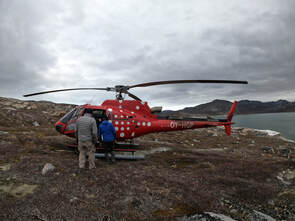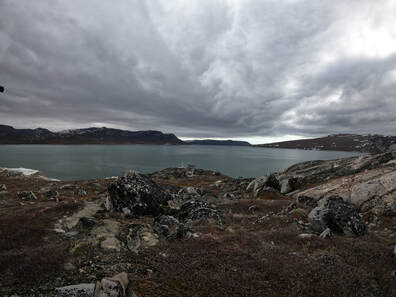
Hi there! Welcome to Dave and I’s third and final post. Following the boat, we were able to explore some of Ilulissat and had lots of fun doing so. First, I will set the scene - the town is bordered on one side by Disko Bay and a multitude of icebergs, and on the other by snow-covered hills. Most of the houses are painted in bright colours providing a striking contrast to the rest of the landscape. The town’s center has a harbour through which fishing boats are constantly filtering in and out. One morning, Dave, Peng, Brian, and I visited the Ilulissat Icefjord which is the passageway through which ice calved from the Ilulissat Glacier (the most productive glacier outside of Antarctica) reaches Disko Bay and the ocean. We hiked along the shore of the icefjord and in the surrounding hills.

On June 11th, Dave and Peng flew back home :( while David, Brian, and I went to the second GNSS site located on a small island on the other side of the icefjord. It took about 15 minutes by helicopter to reach – and we witnessed some pretty incredible sights in those minutes (attached). Like at the first site, the wires to the camera and weather station had been chewed, so the data for those only lasted a few months. However, this time the GNSS station had maintained power and consequently had a large and up-to-date time series. Youpiee! David postulated that the wires were being chewed by animals attracted to the heat from the electricity (thinking it might be a tasty snack). Next time, we are aiming to add protective casing to the wires.

The next two days were spent downloading and organizing the data from the cameras and receivers of both sites. I learned that it is best practice to save your data on at least two devices, and also, if possible, to keep it on the original instrument until its next use. Having these days in Ilulissat also gave me a chance to tick some things off of my bucket list, such as going for runs around the icefjord and swimming in the Arctic Ocean (did not last long). David and Brian were also gearing up to visit their third and last site located near the glacier. They are planning to camp out for roughly 10 days to service existing equipment. As for me, the journey back home went much more smoothly than the first, which I am very (very) grateful for. And this brings me to the end of the story.

I am still in disbelief that I was able to participate in this fieldwork. I have learned so much about what it means to do field work (including the unwanted (but inevitable) plot twists, the need for persistence and organisation, and the excitement that comes when things do go right) and about the processes occurring in this region. I also feel incredibly lucky to have gained some insights on what it is like to live in Greenland, albeit very preliminary ones. And I am glad to have gone through this experience with a great group of people, which made it all the better.
Thanks for reading,
Izzy
Thanks for reading,
Izzy
 RSS Feed
RSS Feed